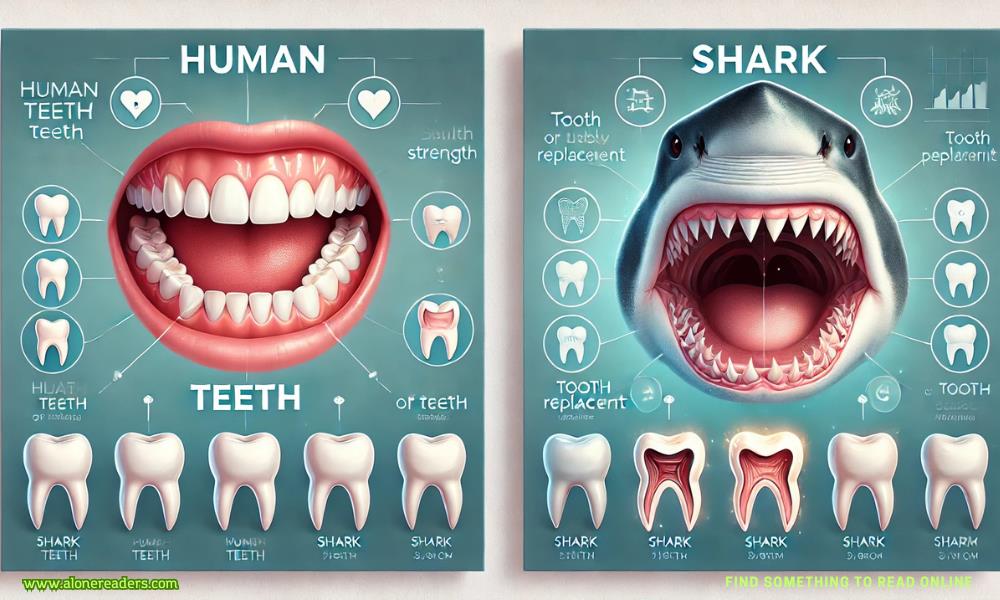
It may be surprising to many that human teeth are as strong as a shark’s teeth. Despite the differences in appearance and function, both human and shark teeth have developed to be resilient tools for survival. Humans rely on their teeth for chewing and breaking down food, while sharks use theirs for tearing into prey. What connects these two seemingly different species is the toughness of their teeth. Scientific studies have shown that the enamel coating on human teeth is just as strong as the enamel on shark teeth, highlighting an interesting parallel between the two species.
Human teeth are composed of layers, with the outermost being the enamel, the hardest substance in the human body. Beneath the enamel is the dentin, which supports the tooth’s structure. Sharks, on the other hand, also have a similar structure, with a strong enamel layer protecting their teeth. Despite the fact that shark teeth are exposed to far more pressure and wear due to their hunting habits, the composition of their teeth allows them to hold up remarkably well. The strength of both human and shark teeth comes down to the incredible durability of their enamel, which can resist damage and pressure.
What’s even more fascinating is that, like humans, sharks lose their teeth as well. Humans lose their baby teeth early in life, making way for their permanent set of adult teeth. Sharks, however, continuously lose and regrow teeth throughout their entire lives. In fact, a shark can lose and replace up to 30,000 teeth over the course of its lifetime. This regenerative ability is one of the features that makes sharks such effective predators, ensuring that they always have sharp, functional teeth for catching prey. While humans only go through the process of losing teeth once, sharks’ teeth regeneration is an ongoing cycle.
Humans have a single set of adult teeth that, once lost or damaged, cannot regenerate naturally. This is why dental care is crucial for humans, as their teeth must last them throughout their lifetime. The enamel, though strong, can wear down over time due to poor oral hygiene, acidic foods, or mechanical damage like grinding. In contrast, sharks have evolved to regularly replace their teeth, which is essential for their survival in the wild. This constant renewal ensures that they are always equipped to capture food efficiently.
While the strength of human and shark teeth may be similar, their functions highlight some key differences. Human teeth are designed for a wide variety of functions, including chewing, grinding, and cutting food. The different shapes of human teeth—incisors, canines, premolars, and molars—reflect the versatility needed for an omnivorous diet. Sharks, however, rely on their teeth primarily for gripping and tearing, as their carnivorous diet requires them to attack prey quickly and effectively. Their teeth are generally triangular with serrated edges, perfectly designed to slice through flesh. This specialization has made sharks some of the most efficient hunters in the animal kingdom.
Another aspect that sets human teeth apart is the importance of dental care. While sharks lose their teeth and grow new ones throughout their lives, humans must take great care of their teeth through regular brushing, flossing, and visits to the dentist. Unlike sharks, humans cannot rely on natural regeneration, which makes preventative care and dental health practices essential. Modern dentistry has developed solutions like fillings, crowns, and implants to help people maintain their teeth, but the natural strength of human teeth can still endure if properly cared for.
Sharks’ teeth are structured to withstand the harsh marine environment in which they live. The constant exposure to saltwater and the rough nature of their prey requires teeth that are not only sharp but durable over time. The natural shedding and replacement of their teeth allow them to adapt to any damage they may incur during their lifetime. On the other hand, human teeth, while strong, are more vulnerable to daily wear and tear. The acids produced by certain foods and bacteria in the mouth can erode enamel, leading to cavities and decay. This difference in longevity highlights the importance of human dental care in maintaining the strength of their teeth.
The comparison between human and shark teeth offers insight into how both species have adapted to their environments. Humans, through their reliance on dental care, and sharks, through their natural tooth regeneration, have both found ways to maintain the strength and functionality of their teeth. The fact that human teeth are as strong as shark teeth serves as a reminder of the durability that evolution has built into both species, ensuring survival through the ages.
In conclusion, while human and shark teeth serve different purposes, their strength is remarkably comparable. Both species have developed teeth that can withstand significant force, whether it’s biting into an apple or tearing into prey. However, the key difference lies in how each species deals with tooth loss. Humans must take care of their teeth to avoid permanent damage, while sharks continuously grow new teeth to replace those lost. This unique evolutionary trait in sharks, combined with the shared strength of both species’ teeth, highlights the incredible adaptations in the natural world.